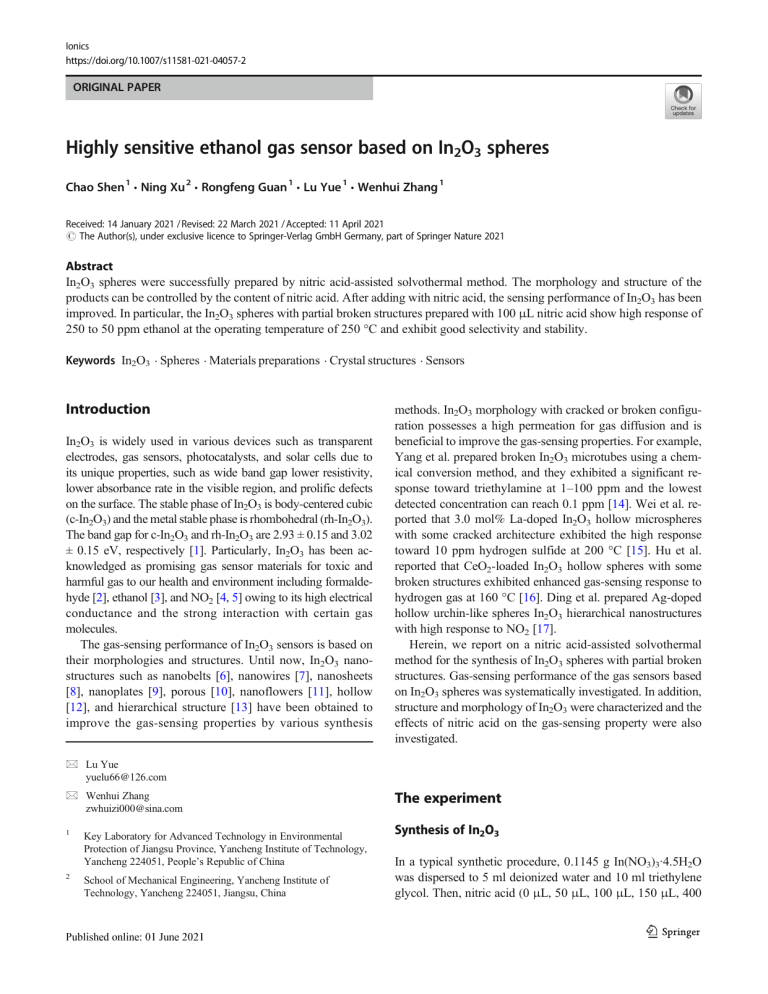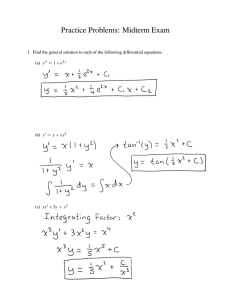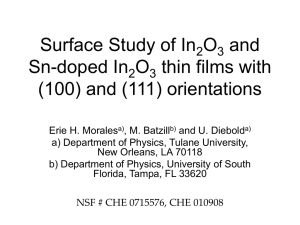
Ionics
https://doi.org/10.1007/s11581-021-04057-2
ORIGINAL PAPER
Highly sensitive ethanol gas sensor based on In2O3 spheres
Chao Shen 1 & Ning Xu 2 & Rongfeng Guan 1 & Lu Yue 1 & Wenhui Zhang 1
Received: 14 January 2021 / Revised: 22 March 2021 / Accepted: 11 April 2021
# The Author(s), under exclusive licence to Springer-Verlag GmbH Germany, part of Springer Nature 2021
Abstract
In2O3 spheres were successfully prepared by nitric acid-assisted solvothermal method. The morphology and structure of the
products can be controlled by the content of nitric acid. After adding with nitric acid, the sensing performance of In2O3 has been
improved. In particular, the In2O3 spheres with partial broken structures prepared with 100 μL nitric acid show high response of
250 to 50 ppm ethanol at the operating temperature of 250 °C and exhibit good selectivity and stability.
Keywords In2O3 . Spheres . Materials preparations . Crystal structures . Sensors
Introduction
In2O3 is widely used in various devices such as transparent
electrodes, gas sensors, photocatalysts, and solar cells due to
its unique properties, such as wide band gap lower resistivity,
lower absorbance rate in the visible region, and prolific defects
on the surface. The stable phase of In2O3 is body-centered cubic
(c-In2O3) and the metal stable phase is rhombohedral (rh-In2O3).
The band gap for c-In2O3 and rh-In2O3 are 2.93 ± 0.15 and 3.02
± 0.15 eV, respectively [1]. Particularly, In2O3 has been acknowledged as promising gas sensor materials for toxic and
harmful gas to our health and environment including formaldehyde [2], ethanol [3], and NO2 [4, 5] owing to its high electrical
conductance and the strong interaction with certain gas
molecules.
The gas-sensing performance of In2O3 sensors is based on
their morphologies and structures. Until now, In2O3 nanostructures such as nanobelts [6], nanowires [7], nanosheets
[8], nanoplates [9], porous [10], nanoflowers [11], hollow
[12], and hierarchical structure [13] have been obtained to
improve the gas-sensing properties by various synthesis
methods. In2O3 morphology with cracked or broken configuration possesses a high permeation for gas diffusion and is
beneficial to improve the gas-sensing properties. For example,
Yang et al. prepared broken In2O3 microtubes using a chemical conversion method, and they exhibited a significant response toward triethylamine at 1–100 ppm and the lowest
detected concentration can reach 0.1 ppm [14]. Wei et al. reported that 3.0 mol% La-doped In2O3 hollow microspheres
with some cracked architecture exhibited the high response
toward 10 ppm hydrogen sulfide at 200 °C [15]. Hu et al.
reported that CeO2-loaded In2O3 hollow spheres with some
broken structures exhibited enhanced gas-sensing response to
hydrogen gas at 160 °C [16]. Ding et al. prepared Ag-doped
hollow urchin-like spheres In2O3 hierarchical nanostructures
with high response to NO2 [17].
Herein, we report on a nitric acid-assisted solvothermal
method for the synthesis of In2O3 spheres with partial broken
structures. Gas-sensing performance of the gas sensors based
on In2O3 spheres was systematically investigated. In addition,
structure and morphology of In2O3 were characterized and the
effects of nitric acid on the gas-sensing property were also
investigated.
* Lu Yue
yuelu66@126.com
* Wenhui Zhang
zwhuizi000@sina.com
1
Key Laboratory for Advanced Technology in Environmental
Protection of Jiangsu Province, Yancheng Institute of Technology,
Yancheng 224051, People’s Republic of China
2
School of Mechanical Engineering, Yancheng Institute of
Technology, Yancheng 224051, Jiangsu, China
The experiment
Synthesis of In2O3
In a typical synthetic procedure, 0.1145 g In(NO3)3·4.5H2O
was dispersed to 5 ml deionized water and 10 ml triethylene
glycol. Then, nitric acid (0 μL, 50 μL, 100 μL, 150 μL, 400
Ionics
μL) was added dropwise into the mixture solution with stirring. The solution was sealed in a 50 ml autoclave and heated
at 180 °C for 12 h. After the reaction, when the autoclave was
cooled to room temperature, the products were collected by
centrifugation and washed several times with deionized water.
The products were dried at 80 °C for 2 h and then calcined in
the furnace at 450 °C in the air for 2 h.
Characterizations
X-ray diffraction (XRD) was performed by PANalytical
X’Pert3 Powder diffractometer. Scanning electron microscopy
(SEM) was measured using scanning electron microscopy
(FEI Nova NanoSEM 450). Brunauer–Emmett–Teller (BET)
surface areas were measured on an Autosorb-iQ-C-TCD adsorption analyzer. Fourier-transform infrared (FT-IR) spectra
were recorded on a NEXUS-670 spectrometer from 4000 to
400 cm−1 at resolution of 4 cm−1. Zeta potential was measured
by a Nano ZS90 Zeta potential and molecular weight analyzer.
Gas-sensing measurements
Gas-sensing properties were detected on a CGS-1TP gas-sensing
measurement system (Beijing Elite Tech Co., Ltd.), which is
shown as Fig. 1a. The system offered an external temperature
control (from room temperature to 500 °C with a precision of 1
°C), which could conductively adjust the sensor temperature directly. Two probes were pressed on sensor substrates to export
electrical signals. The target gas was injected into the test chamber.
The target gas was mixed with air by two fans in the analysis
system. Fig. 1b displays the schematic representation of the planar
ceramic substrate. Ag-Pd interdigital electrodes were preplaced on
Fig. 1 a Schematic representation of the planar ceramic substrate, b gassensing measurement system
the planar ceramic substrate with a space of 0.2 mm. The ceramic
substrate has a width, length, and thickness of 7, 13.4, and 1 mm,
respectively. The sample was mixed with terpineol to form a paste,
which was coated on the planar ceramic substrate and calcined in
air at 450 °C for 2 h. Finally, the fabricated sensor was aged in an
aging test chamber at 80 °C for 48 h and then pre-heated for 30 min
until they reached a stable resistance at the operating temperature.
The sensor response to the test gas was defined as Ra/Rg, where Rg
and Ra were the resistances of the sensors in target gases and in air,
respectively. The response and recovery times were defined as the
time taken by the sensor to achieve 90% of the total resistance
change in the case of adsorption and desorption, respectively. All
the measurements were carried out at room temperature under
atmospheric pressure.
Results and discussion
The crystal structure of the samples was examined by XRD, as
shown in Fig. 2. All the diffraction peaks of the sample prepared without nitric acid were assigned to the mixed phase of
c-In2O3 (JCPDS 06-0416) and rh-In2O3 (JCPDS 22-0336),
and the main phase was rh-In2O3. After adding nitric acid,
the main phase of all samples converted to c-In2O3 (JCPDS
06-0416), and the diffraction peaks of rh-In2O3 were very
weak. It can be seen that the growth of rh-In2O3 was restrained
under acid environment.
The effect of nitric acid content on the morphology was
investigated by SEM, as shown in Fig. 3. In the absence of
nitric acid, the obtained sample was porous nanosheets with a
width of about 340 nm. Further, 50 μL nitric acid was added,
and the morphology was changed to spheres with a diameter
of about 470 nm and nanocubes tightly connected together
onto the sphere surface. When nitric acid was increased to
100 μL, the spheres grew bigger with a diameter of about
620 nm and was composed of many small nanoparticles,
and some spheres were broken, which was probably due to
the chemical etching of strong acid [18]. When nitric acid was
increased to 150 μL, spheres further grew bigger. When the
nitric acid was increased to 400 μL, the product was transformed into agglomerated irregular sphere. Hence, nitric acid
was vital for the morphology of In2O3 spheres. Porous nanosheets were gradually etched to form spheres and some
spheres were broken, which was probably due to the chemical
etching of strong acid. Nitric acid also provided specific acidic
conditions for the hydrolysis of In3+ in a controllable manner.
The BET surface area for the sample prepared with 0, 50, 100,
150, and 400 μL nitric acid was 57.7, 46.7, 81.2, 49.8, and
60.6 m2/g, respectively.
Figure 4 shows the FT-IR spectra of the In2O3 precursor
prepared with 100 μL nitric acid before and after calcining.
Before calcining, the absorption peak at the wave number of
3500–3200 cm−1 corresponds to the stretching vibration of the
Ionics
Fig. 2 XRD patterns of the
samples
Fig. 3 FE-SEM image of samples
prepared with a 0 μL; b 50 μL; c,
d 100 μL; e 150 μL; f 400 μL
nitric acid
Ionics
250
0 l nitric acid
50 l nitric acid
100 l nitric acid
150 l nitric acid
400 l nitric acid
2265
80
1630
1627
1068
852
60
200
150
784
3431
603
565
40
3388
1157
20
0
In2O3 precursor
3124
3234
In2O3
Response (Ra/Rg)
Transmittance (%)
100
501
100
50
425
0
3500
3000
2500
2000
1500
-1
1000
500
100
150
Fig. 4 FT-IR spectra of In2O3 precursor and In2O3 prepared with 100 μL
nitric acid
O–H bond, and the absorption peak at 1627 cm−1 may be the
vibration absorption peak of the hydroxyl group of adsorbed
water molecule, the strong absorption peak at 1200–780 cm−1
should be attributed to the In-OH deformed vibration absorption band, and the absorption peak at 501 cm−1 should be
attributed to the stretching vibration of In–O bond. After calcining, the absorption peak at the wave number of 3431 cm−1
corresponds to the stretching vibration of the O–H bond, and
the absorption peak near 1630 cm−1 may be the vibration
absorption peak of the hydroxyl group of adsorbed water molecule, the three sharp absorption peaks at 425, 565, and 603
cm−1 are the phonon vibration characteristic peaks of cIn2O3. The pH of the In2O3 precursor prepared with 100
μL nitric acid before and after calcining was 4.0 and
6.8, respectively. And the Zeta potential of the In2O3
precursor prepared with 100 μL nitric acid before and
after calcining was 4.6 and − 6.9 mV.
The response of the sensors to 50 ppm ethanol as a function
of the operating temperature is shown in Fig. 5. After adding
nitric acid, the response of all the sensors was improved, and
the sample prepared with 100 μL nitric acid showed highest
response to 50 ppm ethanol. In particular, the response of the
sample prepared with 100 μL nitric acid reached 252 at 250
°C, which was about 10 times of the response (25) of the
sensor without adding nitric acid. The response of the sensor
prepared with 100 μL nitric acid first increased with the operating temperature, reached highest at 250 °C, and then decreased at 300 °C. The response and recovery time of the
sample prepared with 100 μL nitric acid at different operating
temperatures are shown in Table 1. The response and recovery
time of the sample prepared with 100 μL nitric acid at 250 °C
was 16 and 14 s, respectively. The optimum operating temperature was around 250 °C.
Figure 6a shows that the response of all the samples increases rapidly as the ethanol concentration ranges from 5 to
200
250
300
o
Temperature ( C)
Wavenumbers (cm )
Fig. 5 Response of the samples to 50 ppm ethanol at different operating
temperatures
1000 ppm. It can be noticed from Fig. 6b that the response
increased as the ethanol concentration increased. The response
of the sample using nitric acid was superior to the sample
without nitric acid with increasing of ethanol concentration.
In particular, In2O3 prepared with 100 μL nitric acid showed a
more pronounced response, probably due to its partial broken
sphere structure and highest surface areas for better adsorption
and desorption of ethanol.
Figure 6c displays four representative reversible cycles of
samples to 50 ppm ethanol. It illustrated that this series of gas
sensors were well cycled and offer possibilities for the next
work. Fig. 6d shows the response of the samples to 50 ppm
various gases or vapors at 250 °C. It can be seen that the
sensor of In2O3 prepared with 100 μL nitric acid had highest
response to ethanol than other gases. Furthermore, compared
to the sample without nitric acid, it showed more obvious high
response to each gas. This demonstrates the sample showed
good selectivity when nitric acid was used.
As a major factor in the performance of gas sensors, its useful
life for sensor testing is an important measure of its further industrialization. To investigate the stability of the sample prepared
with 100 μL nitric acid, the response to 50 ppm ethanol at 250 °C
over 30 days is indicated in Fig. 7. It can be clearly seen that even
after 30 days of testing, the sensor response did not change much,
still maintaining high response to ethanol.
Table 2 summarizes the gas-sensing properties of various
In2O3 structures to ethanol in the literatures and present study.
Table 1 Response and recovery time of the sample prepared with 100
μL nitric acid at different operating temperatures
Operating temperature/°C
100
150
200
250
300
Response time/s
Recovery time/s
100
80
45
60
20
30
16
14
12
8
Ionics
1200
Response (Ra/Rg)
1000 ppm
0 l nitric acid
50 l nitric acid
100 l nitric acid
150 l nitric acid
400 l nitric acid
1500
500 ppm
250 ppm
on off
0 l nitric acid
50 l nitric acid
100 l nitric acid
150 l nitric acid
400 l nitric acid
1400
750 ppm
900
600
b 1600
Response (Ra/Rg)
a
Fig. 6 a Typical dynamic
response curve of samples to 5–
1000 ppm ethanol. b Response of
the samples to 5–1000 ppm ethanol. c Response curve of samples
to 50 ppm ethanol at operating
temperature of 250 °C. d
Response of the sample prepared
with 0 and 100 μL nitric acid to
various gases or vapors of 50 ppm
at operating temperature of 250
°C
100 ppm 125 ppm
50 ppm
300
1200
1000
800
600
400
200
25 ppm
5 ppm
0
0
400
800
1200
1600
0
2000
0
Time (s)
0 l nitric acid
50 l nitric acid
100 l nitric acid
150 l nitric acid
400 l nitric acid
300
250
Response (Ra/Rg)
400
600
800
1000
Volume (ppm)
200
150
100
d
Response (Ra/Rg)
c
200
0 l nitric acid
100 l nitric acid
250
200
150
100
50
50
0
200
400
600
800
Time (s)
Compared to previous reports, the In2O3 spheres in this work
showed a higher response to ethanol.
When the In2O3 sensor was placed in the air, oxygen
molecules were absorbed on the surface of In 2 O 3
spheres, and electrons were trapped from the conduction
band of the material to form chemisorbed oxygen ions
O−2 ; O2− ; O− , resulting in an increase in electrical resistance. When ethanol gases (a kind of reducing gas) was
injected, the chemisorbed oxygen ions reacted with the
ethanol molecule, C2H5OH is proved to be converted to
CH3CHO when In2O3 was used as the catalytic material
Response (Ra/Rg)
250
200
150
100
50
0
0
5
10
15
20
25
30
Time (day)
Fig. 7 Long-term stability of the sample prepared with 100 μL nitric acid
to 50 ppm ethanol at operating temperature of 250 °C
Et
ha
no
l
A
ce
Fo
to
ne
rm
al
de
hy
de
To
lu
en
e
A
m
m
on
ia
Be
nz
C
yc ene
lo
he
xa
M
ne
et
hy
la
m
in
M
e
et
ha
Is
n
op
ol
ro
pa
no
l
0
0
Gases or vapors
on an alkaline surface [26], CH3CHO may react with
the adsorbed oxygen ions on the sensor surface, and at
the same time, the electrons are released back to the
conduction band, resulting in a decrease in electrical
resistance. The specific reaction process is shown in
the following equation [11].
O2 ðgÞ↔O2 ðadÞ
ð1Þ
−
O2 ðadÞ þ e‐ ↔ O−2 ; O2− ; O ðadÞ
ð2Þ
C2 H5 OH↔CH3 CHO þ H2
ð3Þ
CH3 CHO ðadÞ þ 5O− ðadÞ↔2H2 O ðgÞ þ 2CO2 ðgÞ þ 5e−
ð4Þ
In addition, we know that materials with a high specific
surface area are more advantageous for improving gas response. The unique sphere structure of In2O3 using 100 μL
nitric acid not only provided a bonding site to absorb more
ethanol molecules but also provided an unobstructed path for
easy absorption and desorption of gas molecules. The gassensing properties of metal oxides also depend on grain size,
porosity, lattice defects, active surface state, oxygen adsorption quantity, active energy of adsorption of the test gas on
their surface, and so on. The unique sphere structure of In2O3
using 100 μL nitric acid with partial broken structures may be
beneficial to the gas diffusion. The main phase of In2O3 was
transformed from rh-In2O3 into c-In2O3 after adding nitric
acid, and the phase transformation may also lead to the change
of surface area. More detailed reason and qualitative
[3]
[11]
[19]
[20]
[21]
[22]
[23]
[24]
[25]
This study
Reference
Ionics
explanation about the mechanism of interaction between ethanol and In2O3 need further investigation.
320
280
200
235
200
320
210
260
250
250
185
22
24
30
24.4
28
23
11.7
32.6
250
Response
In summary, In2O3 spheres were prepared by nitric acidassisted solvothermal method. After adding nitric acid,
In2O3 nanosheets were changed into spheres, the main phase
of In2O3 was transformed from rh-In2O3 into c-In2O3, and the
gas-sensing properties of In2O3 was improved. The In2O3
spheres with partial broken structures prepared with 100 μL
nitric acid showed highest response of 250 to 50 ppm ethanol
at the operating environment of 250 °C, short responserecovery time (16 and 14 s, respectively), good selectivity,
cyclicity, and stability toward 50 ppm ethanol. The excellent
gas-sensing properties are mainly attributed to the spheres
with partial broken structures and relatively large surface area.
It is foreseeable that such In2O3 spheres assisted by nitric acid
are promising gas-sensitive materials in the field of gas
sensors.
Funding This work was supported by the National Natural Science
Foundation of China (Nos. 51802276, 21878257).
References
Ethanol
100 ppm
50 ppm
125 ppm
50 ppm
50 ppm
100 ppm
100 ppm
100 ppm
100 ppm
50 ppm
Au-loaded In2O3 hollow microspheres
Porous rh-In2O3 nanoflowers
In2O3 hollow microspheres
Er-doped In2O3 hollow spheres
Porous In2O3 hollow nanorod
Flower-like In2O3 nanostructures
In2O3 microcubes
In2O3/ZnS rough microspheres
In2O3:Pb
In2O3 spheres
1.
Hollow sphere materials
Table 2
Gas-sensing properties of various In2O3 structures to ethanol in the literatures and present study
Temperature (°C)
Conclusion
King PDC, Veal TD, Fuchs F, Wang CY, Payne DJ, Bourlange A,
Zhang H, Bell GR, Cimalla V, Ambacher O, Egdell RG, Bechstedt
F, McConville CF (2009) Band gap, electronic structure, and surface electron accumulation of cubic and rhombohedral In2O3. Phys
Rev B 79:205211
2. Gu FB, Li CJ, Han DM, Wang ZH (2018) Manipulating the defect
structure (V-O) of In2O3 nanoparticles for enhancement of formaldehyde detection. ACS Appl Mater Interfaces 10:933–942
3. Zhang S, Song P, Yan HH, Wang Q (2016) Self-assembled hierarchical Au-loaded In2O3 hollow microspheres with superior ethanol
sensing properties. Sensor Actuators B Chem 231:245–255
4. Gao LP, Cheng ZX, Xiang Q, Zhang Y, Xu JQ (2015) Porous
corundum-type In2O3 nanosheets: synthesis and NO2 sensing properties. Sensor Actuators B Chem 208:436–443
5. Ma HN, Yu LM, Yuan X, Li Y, Li C, Yin ML, Fan XH (2019)
Room temperature photoelectric NO2 gas sensor based on direct
growth of walnut-like In2O3 nanostructures. J Alloys Compd 782:
1121–1126
6. Li YS, Xu J, Chao JF, Chen D, Ouyang SX, Ye JH, Shen GZ
(2011) High-aspect-ratio single-crystalline porous In2O3 nanobelts
with enhanced gas sensing properties. J Mater Chem 21:12852–
12857
7. Singh N, Gupta RK, Lee PS (2011) Gold-nanoparticlefunctionalized In2O3 nanowires as CO gas sensors with a significant enhancement in response. ACS Appl Mater Interfaces 3:2246–
2252
8. Wang J, Su J, Chen H, Zou XX, Li GD (2018) Oxygen vacancyrich, Ru-doped In2O3 ultrathin nanosheets for efficient detection of
xylene at low temperature. J Mater Chem C 6:4156–4162
Ionics
9.
10.
11.
12.
13.
14.
15.
16.
17.
Xu YY, Tian X, Liu P, Sun YQ, Du GX (2019) In2O3 nanoplates
with different crystallinity and porosity: controllable synthesis and
gas-sensing properties investigation. J Alloys Compd 787:1063–
1073
Zhang S, Song P, Zhang J, Yan HH, Li J, Yang ZX, Wang Q (2017)
Highly sensitive detection of acetone using mesoporous In2O3
nanospheres decorated with Au nanoparticles. Sensor Actuators B
Chem 242:983–993
Gao LP, Ren FM, Cheng ZX, Zhang Y, Xiang Q, Xu JQ (2015)
Porous corundum-type In2O3 nanoflowers: controllable synthesis,
enhanced ethanol-sensing properties and response mechanism.
Crystengcomm 17:3268–3276
Zhang T, Gu FB, Han DM, Wang ZH, Guo GS (2013) Synthesis,
characterization and alcohol-sensing properties of rare earth doped
In2O3 hollow spheres. Sensor Actuators B Chem 177:1180–1188
Wang SM, Cao J, Cui W, Fan LL, Li XF, Li DJ (2018) Oxygen
vacancies and grain boundaries potential barriers modulation facilitated formaldehyde gas sensing performances for In2O3 hierarchical architectures. Sensor Actuators B Chem 255:159–165
Yang W, Feng L, He SH, Liu LY, Liu ST (2018) Density gradient
strategy for preparation of broken In2O3 microtubes with remarkably selective detection of triethylamine vapor. ACS Appl Mater
Interfaces 10:27131–27140
Wei DD, Jiang WH, Gao HY, Chuai XH, Liu FM, Liu FM, Sun P,
Liang XS, Gao Y, Yan X, Lu GY (2018) Facile synthesis of Ladoped In2O3 hollow microspheres and enhanced hydrogen sulfide
sensing characteristics. Sensor Actuators B Chem 276:413–420
Hu J, Sun YJ, Xue Y, Zhang M, Li PW, Lian K, Zhuiykov S, Zhang
WD, Chen Y (2018) Highly sensitive and ultra-fast gas sensor
based on CeO2-loaded In2O3 hollow spheres for ppb-level hydrogen detection. Sensor Actuators B Chem 257:124–135
Ding MD, Xie N, Wang C, Kou XY, Zhang H, Guo LL, Sun YF,
Chuai XH, Gao Y, Liu FM, Sun P, Lu GY (2017) Enhanced NO2
gas sensing properties by Ag-doped hollow urchin-like In2O3 hierarchical nanostructures. Sensor Actuators B Chem 252:418–427
18.
19.
20.
21.
22.
23.
24.
25.
26.
Shuang Y, Xu CY, Hu SP, Wang WS, Jing Y, Liang Z (2016)
Solvothermal synthesis of InOOH nanospheres with enhanced photocatalytic activity. Bull Kor Chem Soc 37:522–528
Li BX, Xie Y, Jing M, Rong GX, Tang YC, Zhang GZ (2006)
In2O3 hollow microspheres: synthesis from designed In(OH)3 precursors and applications in gas sensors and photocatalysis.
Langmuir 22:9380–9385
Zhang T, Chen M, Gu FB, Han DM, Wang ZH, Guo GS (2012)
Alcohol sensing properties of Er-doped In2O3 hollow spheres.
Integr Ferroelectr 138:117–122
Tao K, Han X, Yin Q, Wang D, Han L, Chen L (2017) Metalorganic frameworks-derived porous In2O3 hollow nanorod for
high-performance ethanol gas sensor. Chemistryselect 2:10918–
10925
Han D, Song P, Zhang HH, Yan HH, Xu Q, Yang ZX, Wang Q
(2014) Flower-like In2O3 hierarchical nanostructures: synthesis,
characterization, and gas sensing properties. RSC Adv 4:50241–
50248
Zhou XX, Qu FD, Zhang BX, Jiang CJ, Yang MH (2017) Facile
synthesis of In2O3 microcubes with exposed {100} facets as gas
sensing material for selective detection of ethanol vapor. Mater Lett
209:618–621
Chen Q, Ma SY, Xu XL, Jiao HY, Zhang GH, Liu LW, Wang PY,
Gengzang DJ, Yo HH (2018) Optimization ethanol detection performance manifested by gas sensor based on In2O3/ZnS rough microspheres. Sensor Actuators B Chem 264:263–278
Montazeri A, Jamali-Sheini F (2017) Enhanced ethanol gas-sensing
performance of Pb-doped In2O3 nanostructures prepared by
sonochemical method. Sensor Actuators B Chem 242:778–791
Pouilloux Y, Metayer S, Barrault J (2000) Synthesis of glycerol
monooctadecanoate from octadecanoic acid and glycerol.
Influence of solvent on the catalytic properties of basic oxides. J
Mol Catal A Chem 3:589–594
Publisher’s note Springer Nature remains neutral with regard to jurisdictional claims in published maps and institutional affiliations.


